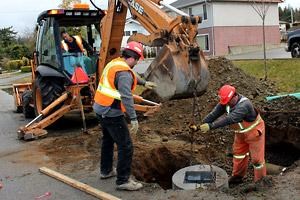City of Powell River officials have been turning their attention to asset management, developing plans to deal with aging infrastructure.
The city was one of four case studies undertaken by Asset Management BC to develop a generic asset management roadmap, a guide for implementing asset management practices. The case study report for each organization included establishing current asset management practices, then comparing the current situation with the work that needs to be in place to achieve a basic level of asset management practice. Through participation in the project, the city gained an improvement plan for asset management that it can put in place over the next few years.
Bernadette O’Connor, a senior asset management consultant with Opus International Consultants, the company that won the bid to develop the roadmap and conduct the case studies, made a presentation to city council recently. She explained that asset management practices all lead to one thing, sustainability. “That’s your objective,” she said. “That’s the reason you do asset management.”
Sustainability and asset management are one and the same thing, said O’Connor. “You can put down any kind of sustainability goals you like, but unless you’ve got asset management, you could never prove that you are or are not sustainable, because you won’t have the data. It will be just a bunch of nice words and nice goals sitting there, but you could never actually demonstrate to your community how sustainable you are.”
The whole purpose of asset management is to reach a position of long-term sustainability, O’Connor said. “You’re managing your assets to be able to keep providing the services to the community into the future. You do that through informed decision making. This is the key.”
The roadmap identifies 17 modules of practice that should be in place for basic level asset management. The city needs to know what assets it has, its current financial position and have an integrated, multi-year program for the future, O’Connor said. “You should be able to see the complete picture, adding together all of the requirements for all of your asset groups and seeing the big picture. You should have prioritization. Everything should be linked to your strategic goals that you are communicating to your public.”
The replacement of assets needs to have as much priority locked into it as operations and maintenance, said O’Connor, as it is intrinsically linked to the sustainability of service. Except for rare occasions, the city will be replacing assets when they age and break, because they provide services that it has an obligation to continue to provide.
The city’s assets include roads. At a recent committee-of-the-whole meeting, Jeremy Sagebiel, engineering technologist, provided an update of the pavement management program, which the city had funded in the past. The focus was on high-volume roads and while those have been upgraded, other roads have been deteriorating because there is no funding for road reconstruction. He suggested the city should look at other options, such as narrowing wide roads, creating bike and pedestrian lanes and turning some roads back to gravel.
Those kinds of decisions would be made through an asset management plan.
Richard Stogre, manager of engineering services, gave a report about asset management at the March 15 committee-of-the-whole meeting. He displayed a series of graphs that showed when individual assets might need to be replaced. “Asset management will give us the tool that more clearly demonstrates the importance of what we need to do,” he said. “The graph itself demonstrates that we really need to look hard at this point at putting some effort into planning so that we can actually address the future needs of the assets.”
Stogre estimated it would cost about $120,000 to establish a basic asset management program within a year. It’s expected that council will discuss the issue and its costs during budget deliberations.



